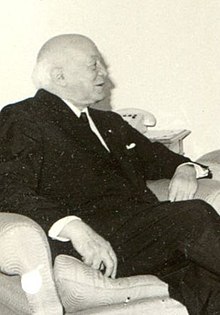Henri Marie Coanda
Henri Marie Coandă ( ; * June 7, 1886 in Bucharest ; † November 25, 1972 ibid.) Was a Romanian physicist and aerodynamicist . He discovered the Coandă effect named after him .
Life
Henri Marie Coandă was born in Bucharest as the second child of a family of nine. His father was the general and politician Constantin Coandă . His mother, Aida Danet, was the Brittany- born daughter of the French doctor Gustave Danet.
Coandă attended the Petrache Poenaru School and the Sf.-Sava-Lyceum ( Colegiul Național "Sfântul Sava" CNSS) in Bucharest. In 1899, at the request of his father, he went to the Army Lyceum in Iași (Școala Fiilor de Militari din Iași) , which he completed in 1903 as a sergeant major . He then went to the military college for shipbuilding and artillery in Bucharest and was transferred to Germany in 1904 with an artillery regiment. In the same year he enrolled at the Technical University in Berlin-Charlottenburg .
In 1905 he built an airplane for the Romanian army.
From 1907 to 1908 Coandă studied at the Montefiore Institute of the University of Liège , where he met Gianni Caproni . In 1908 he returned to Romania and was an officer in the second artillery regiment. He could not get used to the military discipline and after his release went on an automobile trip to Isfahan , Tehran and Tibet . After his return he went to Paris in 1909 to the Ecole Supérieure D'Aéronautique et de Construction Mécanique (today Institut Supérieur de l'Aéronautique et de l'Espace , also SUPAERO) where he became an aeronautical engineer in 1910.
With the Coanda 1910 , he built the first aircraft with a jet engine (more precisely: Thermojet ). During the first test flight with it, on December 10, 1910, he discovered the Coandă effect named after him . As the aircraft landed, he observed how the gases and flames from the engine spread along the fuselage of the aircraft. The aircraft caught fire and was completely destroyed. A replica of this aircraft is located in the Muzeul Militar Central in Bucharest and in the departure hall of the Bucharest airport named after him.
In 1911 Coandă built a twin-engine aircraft with only one propeller. Two Gnome seven-cylinder radial engines were attached parallel to the fuselage and acted on a four-blade propeller made of wood.
From 1911 to 1914 he was technical director of the Bristol Aircraft Company , then until 1916 at Delaunay-Belleville , where he designed some aircraft.
In 1935 he built an aircraft in the form of a flying saucer based on the Coandă effect , which he called Aerodina Lenticulara . This concept was later further developed in Canada by the company Avro Canada under the name Avro Canada VZ-9AV Avrocar .
Coandă also dealt with the longevity of people from different regions, including those of the Hunzukuts in northern Pakistan.
1970 Coandă became a member of the Romanian Academy . The international airport of Bucharest-Otopeni is named after him today.
Web links
- Flanagan Research: Henri Coanda - Life and Research
- Henri COANDA: Coanda Effect - US Patents, at rexresearch.com (English)
Individual evidence
- ↑ a b Marina Bădulescu: 130 de ani de la naşterea lui Henri Coandă, inventatorul primului avion cu reacție din lume. agerpres.ro, June 6, 2016, accessed October 7, 2016 (Romanian).
- ↑ SCIENTIFIC BASIS OF COANDA'S WORK IN 1910. ( PDF ; 629 kB) Retrieved on August 17, 2018 (English).
- ^ A b Henri Coanda - Life and Research at flanagan-forschung.de
- ↑ Dr. Henri Coandă at Flightglobal on January 18, 1973, p. 76 (English)
- ↑ Information on Coandă's research on Hunza water at biophysica.com accessed on August 17, 2018 (English)
| personal data | |
|---|---|
| SURNAME | Coanda, Henri Marie |
| BRIEF DESCRIPTION | Romanian physicist and aerodynamicist |
| DATE OF BIRTH | June 7, 1886 |
| PLACE OF BIRTH | Bucharest |
| DATE OF DEATH | November 25, 1972 |
| Place of death | Bucharest |

